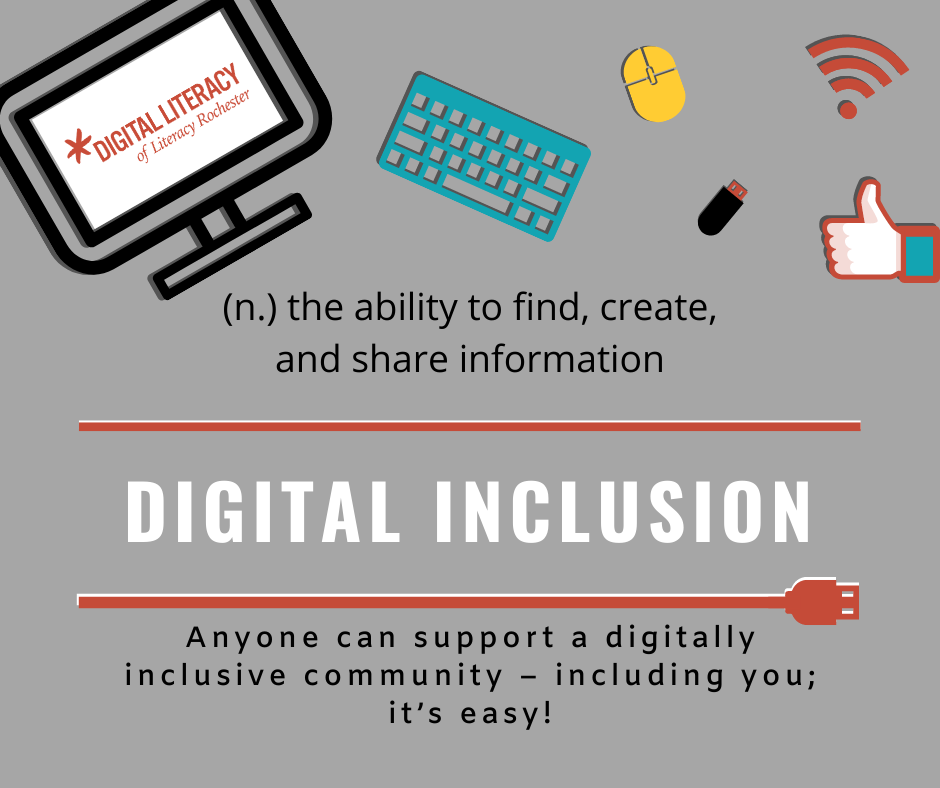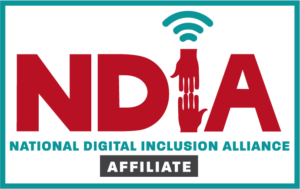
It’s National Digital Inclusion Week and Literacy Rochester has pulled together a list of the most important things you should know.
1. Digital inclusion is in response to the digital divide in our country
The digital divide is defined by Merriam-Webster as “the economic, educational, and social inequalities between those who have computers and online access and those who do not”.
We believe the digital divide is expanding to include disparities between individuals who do and do not have digital skills (e.g., internet, software or applications know-how) and an understanding of how to safely navigate the web.
2. The digital divide has serious negative impacts
Being left behind in a world that is moving faster and faster toward digital-only access has very real consequences.
On an individual level, being excluded means less access to public services as well as opportunities to find and apply to jobs; it means online educational resources are not being accessed by those who may need them most; it may mean that individuals are subject to social exclusion and therefore isolation. The list can go on. In general, people who are unable to engage with today’s digital world have a lower quality of life. Digital inclusion reverses that.
Moreover, there are societal impacts that affect all of us. For example, more than 8 in 10 middle-skill jobs (82%) require digital skills, a 4% increase since 2014.* Chronically un- or underemployed residents may contribute more to social issues such as increased crime rates and higher levels of public assistance, which affect taxes. Communities with higher levels of education and/or higher employment rates have seen decreased reliance on public assistance.
3. Many Monroe County residents are being left behind
Many Monroe County residents are no strangers to digital exclusion, which disproportionately affects:
- People in lower-income households
- Individuals with lower levels of education / no qualifications
- Minorities
- Senior citizens
- Refugees and immigrants
- People with physical, intellectual, or sensory disabilities as well as developmental disorders
- Other highly vulnerable and disadvantaged groups
The digital divide has created the need for communities, especially ours, to proactively pursue digital inclusion.
4. Digital inclusion comprises 5 elements
Per the National Digital Inclusion Alliance (NDIA):
Digital inclusion refers to the activities necessary to ensure that all individuals and communities, including the most disadvantaged, have access to and use of information and communication technologies.
This includes five elements:
- Affordable, robust broadband internet service
- Internet-enabled devices that meet the needs of the user
- Access to digital literacy training
- Quality technical support and
- Applications and online content designed to enable and encourage self-sufficiency, participation and collaboration.
Digital Inclusion must evolve as technology advances. Digital inclusion requires intentional strategies and investments to reduce and eliminate historical, institutional and structural barriers to access and use technology.
5. Anyone can support a digitally inclusive community – including you; it’s easy!
Literacy Rochester’s Digital Literacy program is a community-based digital inclusion program. We tackle digital inequities by providing digital literacy training through our volunteer force and through partnerships with the Rochester Public Library, OACES, and others.
Here are a few ways that YOU can encourage digital inclusion:
- Advocate for digital equity (e.g., encourage your organization to support The Digital Equity Act of 2019)
- Become a Digital Literacy Volunteer and help adults in our community learn digital skills
- Donate used/refurbished electronics to eligible nonprofits
- Make a monetary donation to digitally inclusive programs such as Digital Literacy
- If you’re a business owner, consider how your organization requires customers to use technology and make it more accessible, if possible (e.g., enable text-to-voice on websites, consider what’s intuitive for one individual may not be for someone who lack digital skills and try to streamline and reduce steps)
*Bradley, Ben, and Dan Restuccia, Chris Rudnicki, Scott Bittle (2017). The Digital Edge: Middle-Skill Workers and Careers. Retrieved 10/8/2019 from https://www.burning-glass.com/wp-content/uploads/Digital_Edge_report_2017_final.pdf

Sharing is caring!
